Pros
Cons
Introduction
Design & Appearance
{{section_header}}{{section.name}}{{/section_header}}
Of the waterproof cameras we've reviewed this year at CP+, the Olympus TG-820 has the most traditional look and aesthetic. The tough-cam design of the TG-820 has the look and feel of a tank or lock box, with its brushed metal exterior and thick, rectangular shape. It doesn't look like a toy like the Canon D20, and it doesn't feel like a sporty adventure cam like the Pentax WG-2. The TG-820 is more sophisticated, more polished, and, in a way, it's more bland. Maybe it's a tough-cam for people who don't want to overtly advertise they have a rugged camera. Although, Olympus does print the word "Tough" in huge letters on the front of the camera—so it's hard to conceal the fact that you're carrying around a durable camera when it has that branding.
The TG-820 is available in black, silver, red, or blue.
Tour
{{section_header}}{{section.name}}{{/section_header}}




Menu
{{section_header}}{{section.name}}{{/section_header}}
The main menu system on the TG-820, which is the menu that comes up when you press the menu button on the back of the camera, is designed well and looks slick. The text is easy to read, the pages are easy to navigate (for the most part), and the layout is solid. However, the camera's function menu, which appears at the side of the screen when you press in the joystick button, is much harder to use. This small menu stuffs in a ton of controls and options, most of which are difficult to understand unless you know the TG-820 intimately.
Ease of Use
{{section_header}}{{section.name}}{{/section_header}}
The first thing we noticed about the TG-820 was the camera's very poor button design. We found ourselves fumbling over the camera's d-pad joystick, and our larger-than-average fingers had a horrible time pressing just one button at a time (the buttons are too cramped). Then there's the terrible zoom toggle on the top of the camera, which is so poorly designed that it felt like a joke underneath our index finger. The zoom toggle had almost no give when we pushed it, so it was difficult to get smooth, consistent zooms with the toggle no matter how hard we tried.
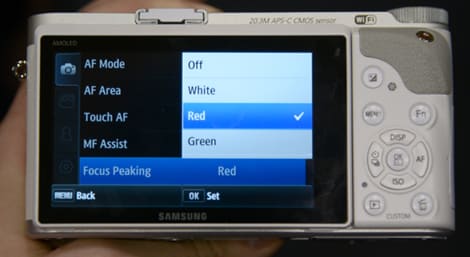

Size & Handling
{{section_header}}{{section.name}}{{/section_header}}
Olympus was able to make the TG-820 a tiny bit lighter than its predecessor, but not by much. The new cam weighs around 206g (7.3 oz.), which is just 9g lighter than last year's TG-810 (that's without batteries for both models). Despite this reduction in weight, the TG-820 is a bit larger than the TG-810, but, again, the difference is very slight (just a tenth of an inch here and there).
The look of the two cameras isn't all that different either. The TG-820 has a new textured grip on the front side of the camera that wasn't present on the TG-810, and the back of the TG-820 features an entirely different button layout than its predecessor. Unfortunately, the changes didn't make the TG-820 any easier to grip. That's something Olympus must work on with its next generation of waterproof cameras.
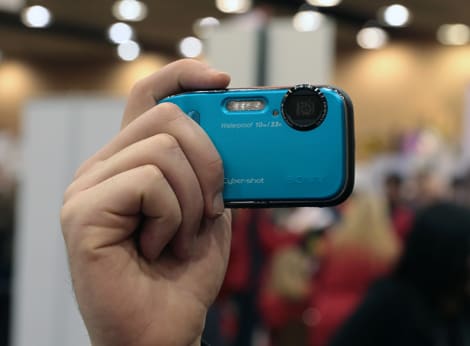
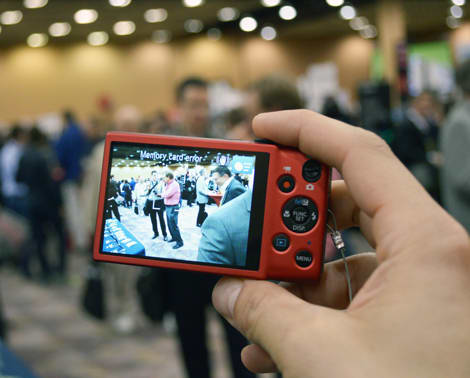
Modes Overview
{{section_header}}{{section.name}}{{/section_header}}
It was hard to get a good feel for the TG-820's handling in auto mode. The camera's autofocus appeared to struggle at times, but that was the horrible mixed lighting of the CP+ trade show in Japan. We assume things would work a lot more smoothly outdoors under natural light. Olympus includes a bunch of picture effects and filters that are actually fun to play around with as well, but nearly all of them are things you could add in post-production (even with a cheap photo editing program).

Auto Mode
{{section_header}}{{section.name}}{{/section_header}}
Olympus calls its dedicated auto mode on the TG-820 "Intelligent Auto", and the company claims this function has been improved compared to last year's TG-810. Intelligent Auto does the same things that most dedicated auto modes do. It automatically picks out a scene mode for you to use that's based on the lighting and shooting information obtained by the camera. Olympus says there are 30 different scene combinations from which the camera can choose from, including Portrait, Landscape, Night and Portrait, Macro, or Sports.
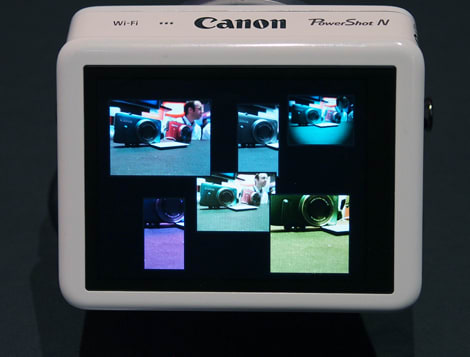
Movie Mode
{{section_header}}{{section.name}}{{/section_header}}
Olympus beefed up the movie mode on the TG-820 compared to last year's TG-810. The new camera now records Full HD 1080p video and you can playback this video by hooking up the camera to an HDTV (via the TG-820's HDMI output). Last year's TG-810 did record HD video, but it topped out with a 720p resolution.
Drive/Burst Mode
{{section_header}}{{section.name}}{{/section_header}}
There's quite a bit to talk about with the TG-820's burst modes. The camera features a new high-speed shooting option that will take up to 25 full-resolution 12-megapixel images at 5fps—not too shabby for an adventure-cam. If you absolutely need to make sure you don't miss any of the action, Olympus also equipped the camera with a 60fps and a 15fps high-speed shooting mode. These two high-speed options capture limited-resolution 3-megapixel images, but you can snap up to 100 images in a single click.
Additionally, the camera is outfitted with a self-timer that can be set to 12-seconds, 2-seconds, or "pet auto" (we assume this takes a photo when an animal is detected within the frame).
Playback Mode
{{section_header}}{{section.name}}{{/section_header}}
Playback options on the Olympus TG-820 aren't all that exciting, but maybe that's a good thing. All you need to really do in playback mode is to be able to play your photos back, right? The camera has a few different view options, the ability to enlarge your photos, and a slide-show setting.
Picture Quality & Size Options
{{section_header}}{{section.name}}{{/section_header}}
Interestingly, the Olympus TG-820 has a lower maximum resolution photo setting than its predecessor. The TG-810 was able to capture 14-megapixel images, while the TG-820 tops out with 12-megapixel photos (3968 x 2976). This does not mean the TG-820 will take worse or less sharp pictures than its predecessor, however. We've said it before, and we'll say it again—higher-pixel counts don't mean higher-quality images. Since the TG-820 has an entirely new image sensor, it's entirely possible that Olympus purposely decided to lower the pixel count in order to make the pictures look better... we'll have to wait and see when we get the TG-820 into our labs for a full test.
Along with the top size option of 12-megapixels, the TG-820 has six other photo size settings going all the way down to a 640 x 480 VGA image. This is a smaller amount of size options than we saw on the Canon D20 and Pentax Optio WG-2, the two other waterproof cameras we've taken a look at during the 2012 CP+ convention in Japan.
Other Modes
{{section_header}}{{section.name}}{{/section_header}}
There's a fun and rather silly 3D image capture mode on the TG-820, but it's not as exciting as it sounds... or maybe 3D photos don't really excite anyone anymore. All the mode does is take two photos and overlap them to create a 3D effect—it's not that interesting. The in-camera panorama mode is actually a bit cooler.
Focus
{{section_header}}{{section.name}}{{/section_header}}
The autofocus on the TG-820 didn't always work very well when we tried it out inside the convention center at CP+. Part of the problem may have to do with the camera's lack of an AF illluminator, but it's also true that many cameras struggle with focus when shooting under shoddy lighting conditions. The camera uses a CMOS contrast detection system in order to focus properly when you press the shutter button down halfway, and you can switch between a few different autofocus modes on the camera.
Exposure & Metering
{{section_header}}{{section.name}}{{/section_header}}
As is the case with most compact tough-cams, the Olympus TG-820 does not offer aperture or shutter speed control on the camera. There's a basic exposure compensation setting, though, that lets you adjust exposure on a -2 to +2 scale (in 1/3 EV steps).
Aperture and shutter speed are both selected automatically by the camera, with the longest shutter speed option being 1/4 of a second (except when using the Night Scene mode, which has a 4 second shutter speed). The widest aperture on the camera is f/3.9.
ISO
{{section_header}}{{section.name}}{{/section_header}}
You can pick your ISO on the TG-820, and the camera has a range from ISO 100 to ISO 6400. There's also an auto ISO setting and a high ISO option when you really want to crank up the gain. The two highest ISO options on the camera, ISO 3200 and ISO 6400, both were not available on the TG-810.
White Balance
{{section_header}}{{section.name}}{{/section_header}}
Olympus loaded the TG-820 with a solid set of white balance presets: Overcast, Sunlight, Tungsten, Fluorescent 1, and Underwater. There's also a manual one-touch white balance preset and an auto white balance mode on the camera.
Image Stabilization
{{section_header}}{{section.name}}{{/section_header}}
The TG-820 offers what Olympus calls "Dual Image Stabilization". The feature essentially utilizes an actual IS system (that uses sensor-shift technology) with a high ISO setting and fast shutter speeds to reduce motion blur. So the "dual" part of the equation isn't really a stabilization function at all, but it does help limit blur by changing other settings on the camera.
Picture Effects
{{section_header}}{{section.name}}{{/section_header}}
Picture effects is an area where Olympus outdoes the competition (although Canon does include some interesting color modes on its D20 camera). The TG-820 has a whole slew of "Magic Art Filters" that let you add special effects to your photos and videos. The filter effects include Pop Art, Pin Hole, Drawing, Fish Eye Effect, Soft Focus, Punk, Watercolor, Miniature, Reflection, and Dramatic Tone. Many of these art filters are also found on Olympus' interchangeable lens PEN cameras as well. Some will say they're cheesy—and you can do many of these effects using photo editing software—but they are fun to play with nevertheless.
There's also a Beauty Mode on the TG-820 that Olympus claims will make your subjects "look like a star!" Beauty mode is basically an extensive soft skin mode that smooths skin tones, removes blemishes, and reduces shadows on the face of your subjects.
Other Controls
{{section_header}}{{section.name}}{{/section_header}}
The backlight HDR mode is something we've seen before on many cameras, and it's a feature that can be useful in the right situation. The HDR mode takes a few photos at once, each at different exposure levels, and then blends them into one image that should have better exposure than a photo shot using the camera's standard setting. It works best for a shot that has a lot of shadowy details and a mix of bright and dark sections in the frame.
Lens & Sensor
{{section_header}}{{section.name}}{{/section_header}}
The lens on the TG-820 offers 5x optical zoom, but Olympus advertises the camera as having a 10x super zoom function that is achieved by using a combination of optical and digital zoom technologies. Since the zoom ratio and focal length is the same as last year's TG-810 from Olympus, there's really not much that seems different about the lens on the new camera.
The image sensor is a different story. Olympus decided to go with a BSI CMOS sensor on the TG-820, which is an entirely different imager than the company used on last year's TG-810 camera. It appears numerous manufacturers made the switch from CCD to CMOS this year, as we saw the same change on the Canon D20 and Pentax WG-2. Surprisingly, Olympus actually downgraded the pixel count on the TG-820's new sensor to 12 megapixels (it was 14MP on the TG-810). We think this reduction in pixel size won't worsen the image quality, though—and we wouldn't be surprised if the new sensor and smaller pixel concentration actually made for better performance overall.

LCD
{{section_header}}{{section.name}}{{/section_header}}
The TG-820 has the same size screen as last year's TG-810, but the pixel count of the screen has been slightly increased. The new cam has a whopping 1,030,000-pixel resolution LCD, which is extremely high for a point-and-shoot camera. This should make your pictures look better when you review them, and it should give you more detail and accuracy when you frame the image.

Flash
{{section_header}}{{section.name}}{{/section_header}}
The flash on the TG-820 isn't anything incredibly unique, but at least it's there. Flash options include red-eye reduction, fill-in, off, and auto, and Olympus lists the working range as 0.2m - 3.5m.

Jacks, Ports & Plugs
{{section_header}}{{section.name}}{{/section_header}}
For some reason, Olympus put tape over the port cover on all of the TG-820's on the show floor at CP+, so we didn't get a good shot of the camera's connectivity options. The ports and jacks are all located on the left side of the camera, in the same area as the memory card slot. The camera has one multi-terminal that functions as a USB port, DC-jack, and AV-output, and it also has an HDMI output.
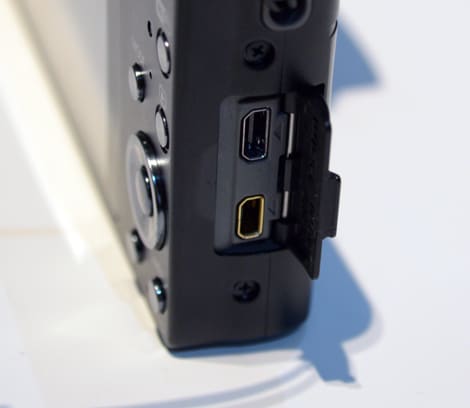
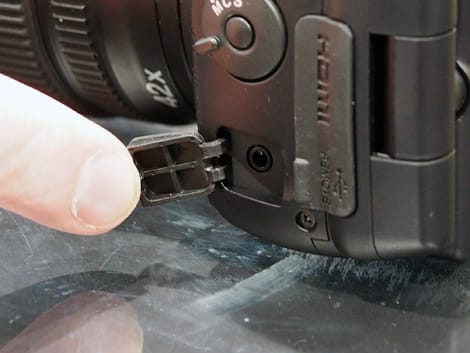
Battery
{{section_header}}{{section.name}}{{/section_header}}
The battery compartment on the TG-820 is also located on the left side of the camera in the same area as the ports and memory card slot. The camera uses a rechargeable battery pack (Li-50B) and ships with a USB-to-AC adapter than is used to charge the battery.

Memory
{{section_header}}{{section.name}}{{/section_header}}
There's just under 50MB of internal memory on the camera, but that's not what you should be using to store your photos. For collecting more than a few photos, you'll need to buy an SD-type memory card (SDHC or SDXC cards are best) and insert it into the camera to store your images.

Other Hardware
{{section_header}}{{section.name}}{{/section_header}}
We looked at a bunch of waterproof cameras at CP+ this year, and the Olympus TG-820 has similar specs to the competition. It is waterproof up to 33 feet (same as the Canon D20, but not as deep as the Pentax WG-2 can travel), shockproof up to 6.6 feet (better than the competition), and freeze-proof down to 14°F (-10°C). It can also withstand 220 pounds of pressure, which is the same spec listed by Canon and Pentax on their waterproof models. TG-820, like most other rugged cams, is dustproof as well. We're still not sure what dustproof means, or how you would quantify "dustproofing", but it is a feature that PR companies must love to talk about.
Conclusion
We like the Olympus TG-820 as a basic tough-cam. Its waterproof specs aren't any better than the competition, but the camera's sophisticated design means it has to be taken seriously. It's got a very different aesthetic than Canon's D20 waterproof camera (more toy-like), and it is even different than the futuristic (and high-tech looking) Pentax WG-2. We weren't all that impressed with the camera's controls and button layout, but we do like the picture effects and art filters that Olympus includes on the model.
The brushed metal coating on the camera looks sturdy and we're confident this camera can withstand a drop from a good distance. Olympus officially lists the TG-820 as shockproof up to 6.6 feet, which is farther than what Canon and Pentax claim their new rugged cams can fall without worry (both are listed as shockproof up to 5 feet).
Surprisingly, Olympus is expected to price the TG-820 at $299, which is $100 less than the original MSRP of last year's TG-810 camera. Did Olympus cut corners in performance in order to make the TG-820 cheaper? Or is this new camera simply a better deal than last year's model? We'll know more when we get the camera into our labs for a full-length review.
{{product.vanity}}
Sample Photos
{{section_header}}{{section.name}}{{/section_header}}
Specs
{{manufacturer_specs_table}}
Meet the tester
Jeremy is the video expert of our imaging team and Reviewed.com's head of video production. Originally from Pennsylvania and upstate NY, he graduated from Bard college with a degree in film and electronic media. He has been living and working in New England since 2005.
Checking our work.
Our team is here to help you buy the best stuff and love what you own. Our writers, editors, and experts obsess over the products we cover to make sure you're confident and satisfied. Have a different opinion about something we recommend? Email us and we'll compare notes.
Shoot us an email